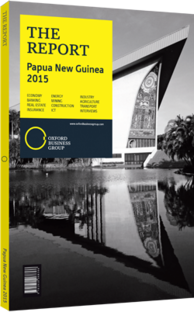PNG hosts development of underwater mine technology
The most unique and potentially profitable mining operation in Papua New Guinea is moving forward again after a funding dispute between Toronto-listed Nautilus Minerals and the PNG government initially slowed development of the underwater mining project following lease approval in 2011. The technically challenging venture, dubbed Solwara 1, employs a range of new proprietary techniques and purpose-built hardware to carry out deep seabed mining in the Bismarck Sea west of central New Ireland, slated to begin as early as 2018.
Solwara 1
Pushing the limits of current mining technology, the Solwara 1 project targets mineral-rich seafloor massive sulphide (SMS) deposits in an area about 1.3 km long and 200 metres wide along the ocean floor. Although environmental groups have warned of ocean pollution and potential damage to sensitive submarine ecosystems from the unproven operation in a subsector still working to establish regulation and oversight, Nautilus has touted underwater mining as having a smaller impact than traditional large-scale mining operations, because it leaves a smaller geographical footprint by targeting high-grade deposits of gold, copper, silver and zinc, thus yielding higher concentrations of metals while generating less waste.
Sitting at a depth of approximately 1600 metres, the targeted SMS deposits contain an indicated resource of 1m tonnes grading at 7.2% copper and gold at 5 grams per tonne for a total estimate of 74,160 tonnes of copper and 165,600 oz of gold. That compares much more favourably with land-based copper mines, where the mineral grade averages just 0.6%. In addition, gold grades of well over 20 grams per tonne have been recorded in some intercepts at Solwara 1, with an average grade of 6 grams per tonne.
Process
To carry out these technical operations, Nautilus has developed three purpose-built, remote-controlled seafloor production vehicles (SPVs) supported by a floating production support vessel (PSV). Remote mining operations will be carried out by the three seafloor production tools engineered to work in the extreme cold and pressure of the subsea environment. Designed to disaggregate seafloor material, the first two machines are auxiliary cutters, the first of which employs a boom-mounted drill apparatus to prepare rough terrain into a level working bench in which the second, higher-capacity bulk cutter can then chew up the seafloor at a more rapid rate.
After these machines have ground out the targeted area, the third machine gathers up the loose cut material in seawater slurry and pumps it to the riser and lifting system (RALS). Powered by a large pump built by GE Hydril of Texas, the RALS pushes the slurry to the surface through a solid vertical pipe, or riser, that is attached to the PSV above. The PSV serves as a base for dewatering the slurry, which is then stored in the 45,000-cu-metre bulk facility on board and subsequently transferred to export vessels that can moor alongside the PSV. When operating at full capacity, these vessels can export 1.3m tonnes of material a year directly to markets via the Port of Rabaul, where it can later be processed or turned into concentrate.
Schedule
Initially scheduled for a production run in 2013, work on the new equipment was delayed by the arbitration proceedings and subsequent commercial negotiations between Nautilus and the government. With the issue now resolved, work on the underwater vehicles was mostly complete by the end of 2014, with a design-and-build contract for the PSV also in place and design under way. All three SPVs were being commissioned in the first quarter of 2015, with delivery expected by year’s end ahead of wet testing in 2016.
Nautilus also entered into a vessel charter agreement with Marine Assets Corporation (MAC) in November 2014, with MAC contracting Fujian Mawei Shipbuilding later that month to construct and deliver the PSV by the end of 2017. As of April 2015, the riser and ancillary equipment were on track for on-time delivery in 2015. “Once MAC delivers the vessel in 2017, completely fitted-out, we will start producing almost immediately,” Michael Johnston, CEO of Nautilus, told OBG.
You have reached the limit of premium articles you can view for free.
Choose from the options below to purchase print or digital editions of our Reports. You can also purchase a website subscription giving you unlimited access to all of our Reports online for 12 months.
If you have already purchased this Report or have a website subscription, please login to continue.

